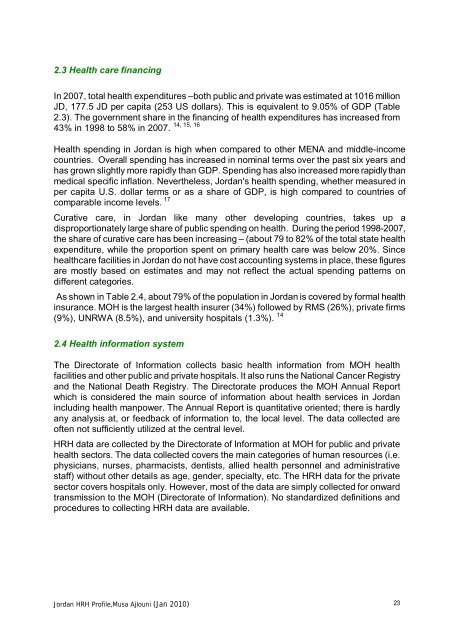Prepared by: Dr. Musa Ajlouni January, 2010 - World Health ...
Prepared by: Dr. Musa Ajlouni January, 2010 - World Health ...
Prepared by: Dr. Musa Ajlouni January, 2010 - World Health ...
Create successful ePaper yourself
Turn your PDF publications into a flip-book with our unique Google optimized e-Paper software.
2.3 <strong>Health</strong> care financingIn 2007, total health expenditures –both public and private was estimated at 1016 millionJD, 177.5 JD per capita (253 US dollars). This is equivalent to 9.05% of GDP (Table2.3). The government share in the financing of health expenditures has increased from14, 15, 1643% in 1998 to 58% in 2007.<strong>Health</strong> spending in Jordan is high when compared to other MENA and middle-incomecountries. Overall spending has increased in nominal terms over the past six years andhas grown slightly more rapidly than GDP. Spending has also increased more rapidly thanmedical specific inflation. Nevertheless, Jordan's health spending, whether measured inper capita U.S. dollar terms or as a share of GDP, is high compared to countries ofcomparable income levels. 17Curative care, in Jordan like many other developing countries, takes up adisproportionately large share of public spending on health. During the period 1998-2007,the share of curative care has been increasing – (about 79 to 82% of the total state healthexpenditure, while the proportion spent on primary health care was below 20%. Sincehealthcare facilities in Jordan do not have cost accounting systems in place, these figuresare mostly based on estimates and may not reflect the actual spending patterns ondifferent categories.As shown in Table 2.4, about 79% of the population in Jordan is covered <strong>by</strong> formal healthinsurance. MOH is the largest health insurer (34%) followed <strong>by</strong> RMS (26%), private firms(9%), UNRWA (8.5%), and university hospitals (1.3%). 142.4 <strong>Health</strong> information systemThe Directorate of Information collects basic health information from MOH healthfacilities and other public and private hospitals. It also runs the National Cancer Registryand the National Death Registry. The Directorate produces the MOH Annual Reportwhich is considered the main source of information about health services in Jordanincluding health manpower. The Annual Report is quantitative oriented; there is hardlyany analysis at, or feedback of information to, the local level. The data collected areoften not sufficiently utilized at the central level.HRH data are collected <strong>by</strong> the Directorate of Information at MOH for public and privatehealth sectors. The data collected covers the main categories of human resources (i.e.physicians, nurses, pharmacists, dentists, allied health personnel and administrativestaff) without other details as age, gender, specialty, etc. The HRH data for the privatesector covers hospitals only. However, most of the data are simply collected for onwardtransmission to the MOH (Directorate of Information). No standardized definitions andprocedures to collecting HRH data are available.Jordan HRH Profile,<strong>Musa</strong> <strong>Ajlouni</strong> (Jan <strong>2010</strong>) 23

















